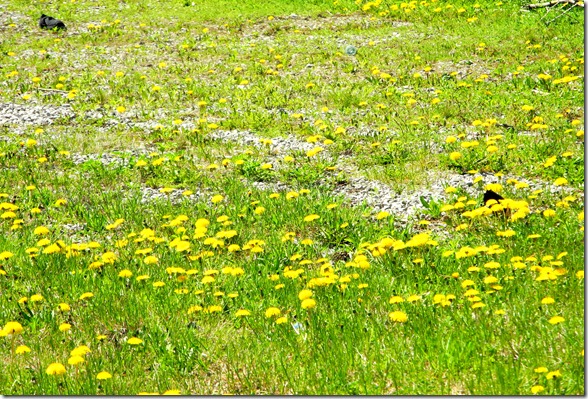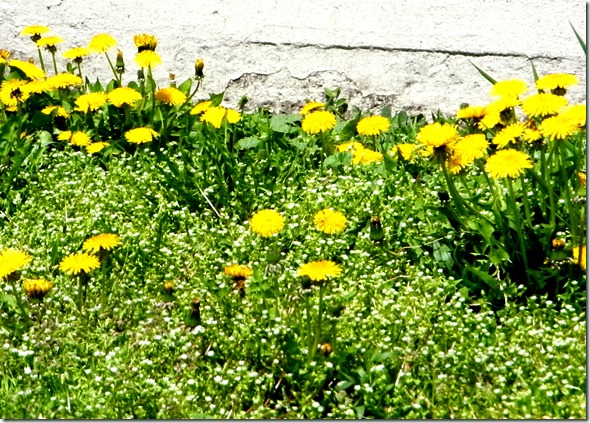I suppose my “spring fever” must be raging when I start to take pleasure in the humble dandelion. I’ll blame my condition upon the cold spring of 2013. When the warm temperatures finally arrived, I hit the streets of the city with renewed fervour. I appreciated more than ever the beauty of a Canadian spring.
My admiration for the common dandelion occurred while I was walking along Queen Street West on a sunny spring morning in early May of 2013. Naturally, I appreciated the numerous spring flowers blooming in the city’s sidewalk-planters and in pots and boxes that the merchants had placed outside their shops. However, I also could not help but notice the tenacious dandelions growing in cracks between the pavement, in tiny strips of soil beside brick walls, and in small grassy areas that had been abandoned to the whims of nature. Because dandelions are a nuisance when they invade the lawns of the city, most people consider them a noxious weed, something to be eradicated by either constant weeding or with pesticides. This is a pity, as their flowers are actually quite attractive and their leaves provide a contrasting bitter taste when mixed with salad greens.
On my walk, it was the ability of the dandelion to survive in extreme conditions that caught my eye. I stopped to gaze at a patch of them growing between the massive stones of the railway underpass, west of Dufferin Street. Then, as I proceeded westward toward Parkdale, I noticed a vacant corner lot where the small yellow flowers sprouted gloriously in an expansive field of unkempt grass. Later, as I passed Roncesvalles Avenue, I saw another area where the dandelions enriched a patch of land covered where other wild flowers were growing.
I wonder if gardeners seriously cultivated dandelions, fertilizing them, and selecting the seeds from those that grew the largest blossoms, if a truly excellent quality flower might be produced. Likely the neighbours would shoot any gardener who attempted such a project as their unwanted seeds would pollute the lawns of the area. However, I can’t help but wonder !
A clump of dandelions perched tenaciously among the stones of the railway underpass, west of Dufferin Street.
Dandelions in a corner lot in Parkdale, on the south side of Queen Street.
Dandelions growing beside a wall, west of the Roncesvalles and King/Queen intersection.
The poem below is quaintly out of date in the modern era. However, it’s finally spring. What the hell !
To the Dandelion
Dear common flower, that grow’st beside the way,
Fringing the dusty road with harmless gold,
First pledge of blithesome May,
Which children pluck, and, full of pride, uphold,
High-hearted buccaneers, o’erjoyed that they
An Eldorado in the grass have found,
Which not the rich earth’s ample round
May match in wealth, thou art more dear to me
Than all the prouder summer-blooms may be.
James Russell Lowell (1819-1891)
This cartoon was in the Toronto Star comic section on Saturday, May 4, 2013
To view the Home Page for this blog: https://tayloronhistory.com/
To view other posts about Toronto that hopefully display less spring fever:
A 5 km walk following the path the American invaders marched on April 27, 1813 during the Battle Of York.
https://tayloronhistory.com/2013/05/02/commemoration-of-the-battle-of-yorkapril-27-1813april-272013/
Toronto’s first cemetery and monument to those who served in the War of 1812
Toronto’s historic cathedral spires
https://tayloronhistory.com/2013/04/25/torontos-architectural-gemscathedral-spires/
Toronto’s vanishing 19th-century store fronts.
The Art Deco bus terminal at Bay and Dundas Streets.
Photos of the surroundings of the CN Tower and and the St. Lawrence Market in 1977
The old Dominion Bank Building at King and Yonge Street
The Canada Life Building on University and Queen Street West.
Campbell House at the corner of Queen Street West and University Avenue
A study of Osgoode Hall
https://tayloronhistory.com/2012/04/12/enjoying-torontos-architectural-gems-osgoode-hall/
Toronto’s first City Hall, now a part of the St. Lawrence Market
Toronto’s Draper Street, a time-tunnel into the 19th century
The Black Bull Tavern at Queen and Soho Streets, established in 1822
History of the 1867 fence around Osgoode Hall on Queen Street West at York Street
Gathering around the radio as a child in the 1940s
The opening of the University Theatre on Bloor Street, west of Bay St.
https://tayloronhistory.com/2012/02/24/the-opening-of-torontos-university-theatre-on-bloor-street/
122 persons perish in the Noronic Disaster on Toronto’s waterfront in 1949
Historic Victoria Memorial Square where Toronto’s first cemetery was located, now hidden amid the Entertainment District
https://tayloronhistory.com/2012/01/09/victoria-square-in-torontos-entertainment-district-is-a-gem/
Visiting one of Toronto’s best preserved 19th-century streets-Willcocks Avenue
The 1930s Water Maintenance Building on Brant Street, north of St. Andrew’s Park
Toronto’s architectural gems-photos of the Old City from a book published by the city in 1912
Toronto’s architectural gems in 1912
https://tayloronhistory.com/2012/12/04/torontos-architectural-gems-in-1912/
Toronto’s architectural gems – the bank on the northeast corner of Queen West and Spadina
https://tayloronhistory.com/2012/12/02/torontos-architectural-gemsbank-at-spadina-and-queen-west/
Photos of the surroundings of the CN Tower and and the St. Lawrence Market in 1977
The St. Lawrence Hall on King Street
https://tayloronhistory.com/2012/04/28/enjoying-torontos-architectural-gems-the-st-lawrence-hall/
Toronto’s streetcars through the past decades
https://tayloronhistory.com/2012/03/26/memories-of-torontos-streetcars-of-yesteryear/
History of Trinity Bellwoods Park
https://tayloronhistory.com/2012/04/09/the-history-and-beauty-of-trinity-bellwood-park/
A history of Toronto’s famous ferry boats to the Toronto Islands





